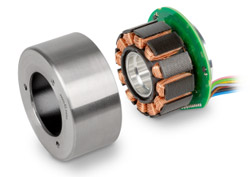
Posted to News on 24th Oct 2018, 15:12
Why specify frameless motors? What are the benefits?
Andrew Gibson, Sales Engineer at maxon UK, explains the benefits of frameless motors for certain applications, and what precautions need to be taken during assembly.

There are several benefits of using frameless motors that include reduced space envelope, reduced mass and a lower parts count. These are all interlinked and can be key factors in numerous applications.
Using a frameless motor, the customer can design this into the assembly without the need of a shaft coupling device to transmit the rotational movement from the motor shaft to the driven element. The shaft will pass through the bore of the rotor and will be one single piece. This will reduce the overall length by a significant factor, as well as removing potential failure modes.
On a housed motor a portion of the overall length is required for the bearings and location features. Depending on the application there are then further bearings to support the driven element of the assembly. By using a frameless motor, the design engineer can use one set of bearings to support the shaft, which is both the motor shaft and the driven element, thereby removing the need for duplicated sets of bearings. Again, this reduces the part count, reduces the space envelope and removes some potential failure modes.
From these simple changes the engineer has more control over the overall size of the assembly and has more flexibility on the package size. By removing the need for couplings and duplicated sets of bearings the part count has reduced. The result is a unit with a smaller housing and less parts, which means a lighter overall package.
Assembly issues
This is all well and good, but a certain amount of care is required in assembly to avoid having issues. All the time magnet grades are improving and getting stronger, which means that maxon can produce more powerful motors in the same space envelope. This also means that when assembling a magnet rotor over a steel stator core, there are strong magnetic forces attracting the two parts together. Without a certain amount of care, there are several issues that a customer could experience. The magnet material is relatively brittle and allowing the rotor to crash into the stator could result in chipping of the magnet. This has two problems: there is a piece of magnet loose in the motor which could cause further damage; in addition, the protective coating has been removed from a portion of the magnet, potentially allowing corrosion of the magnet material to occur. Often the attractive force of the rotor and stator catches people off guard and trapped fingers can occur! However, these issues can be avoided with some simple assembly tooling.
maxon has produced an installation manual for frameless motors, which is available to download from the website product pages. This gives application examples such as the ones below, with ideas on where the bearings can be located on different packaging examples. It also includes ideas for assembly tooling and detailed assembly instructions to avoid the pitfalls above.

Frameless motors are ideal for any application with space constraints and/or a high power-to-weight ratio. Applications such as optical pods, radar systems, azimuth and elevation drives, pan-and-tilt systems, CCTV, as well as rotary joints for robotics and exoskeletons are all good examples.
If you are unsure whether a frameless motor is right for your application, contact the maxon sales team on +44 (0)1189 733 337 or email [email protected] where the company's engineers will be happy to discuss your application in detail and make recommendations. Alternatively, follow the link to find out more about frameless motors from maxon.
Want the latest machine building news straight to your inbox? Become a MachineBuilding member for free today >>

















